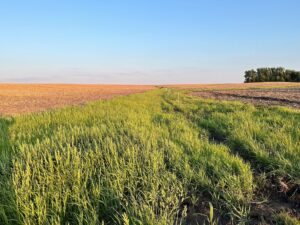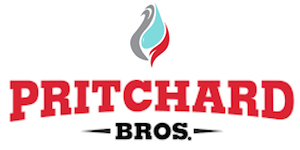AMES, Iowa – Grass waterways across the landscape offer promising opportunities to reduce nitrate pollution in tile drainage from agricultural land, according to ongoing research led by the University of Iowa and Iowa State University.
Linear strips of sod planted in drainageways, grass waterways slow surface water runoff to catch and reduce soil erosion. The widespread conservation practice has been popular for decades in many areas of the state and Midwest.
“Grass waterways in Iowa are usually drained with subsurface tile to prevent moisture from building up and potentially contributing to gullying. The tiles carry the often nutrient-rich water downstream, bypassing the opportunity for natural processing through the soil,” according to Keith Schilling, director of the Iowa Geological Survey at the University of Iowa. “With some simple engineering, our research team is finding that these waterways could serve double-duty to reduce nitrate, functioning similarly to saturated riparian buffers installed along streams.”
In essence, their idea is to catch more of the nitrate-laden drainage flowing through the waterway, and temporarily back it up, step-wise, to re-route it through organic-rich waterway sediment before it exits as cleaner water.
One location where the concept is being tested is on the Porter Family Farm near Reinbeck. Clark Porter originally became aware of the idea from Rick Rottinghaus, a Black Hawk County farmer who was experimenting with a version of a saturated waterway. Porter, working at the time as an environmental specialist for the Iowa Department of Agriculture and Land Stewardship, thought the idea had great potential. His family’s 310-acre farm has several grass waterways. Through a chance meeting with Keith Schilling, Porter learned that a group of Iowa researchers were looking for a location to study a saturated waterway design. He immediately volunteered one of his waterways for the project.
A saturated grass waterway was installed last fall, and it has been functioning very well, he said. He compares the practice to a subterranean “fish ladder,” with little staged pools in stair-step fashion about a foot below the surface.
“Even with the additional test wells for monitoring and the researchers’ visits, being part of this has been very minimally intrusive to our field operations,” Porter said.
Schilling and varying team members over time have demonstrated that saturated grass waterways can significantly reduce nitrate in the water flowing through the subsurface soils, and the waterways can still control erosion.
Their recent research reported in the journal Agricultural Water Management shares results from analyzing soils, nitrate levels and hydrology (water movement) at 22 grass waterways across Iowa, pairing observed data with computer modeling to assess where the practice is likely to work best and offer the greatest water quality benefits. The modeling, led by Antonio Arenas-Amado, assistant professor in the Department of Civil and Environmental Engineering at Iowa State, suggests the practice will work widely, but that the most appropriate locations to further test the practice will be smaller, steeper watershed catchments with more permeable waterway sediments that can capture higher levels of nitrate from crop fields.
A section of northeast Iowa that includes the Porter Family Farm is especially promising.
“My whole family is excited that our farm can be part of this,” Porter said. “This is just one example of innovative, practical designs that have revolutionary potential to efficiently improve water quality in Iowa and beyond. It’s also neat to see how collaborative this project has been.”
In addition to Schilling and Arenas-Amado, scientists involved in the recent research include Matthew Streeter and Valerie Gibertini-Diaz with the Iowa Geological Survey; and Eustice Batret in civil and environmental engineering at Iowa State. The project was funded by Iowa State’s Iowa Nutrient Research Center.
Future plans to study the grass waterway concept include testing the practice at additional sites and conducting a more robust economic analysis.
A virtual field day on saturated grass waterways, hosted by the Iowa Learning Farms and others, is scheduled for Thursday, Jan. 23, 2025, at 1 p.m. Watch for details and registration information at ILF’s events page.

Saturated grass waterway installed with monitoring equipment for research on the Porter Family Farm. Photo courtesy of Clark Porter.

(contributed press release, ISUCALS)










